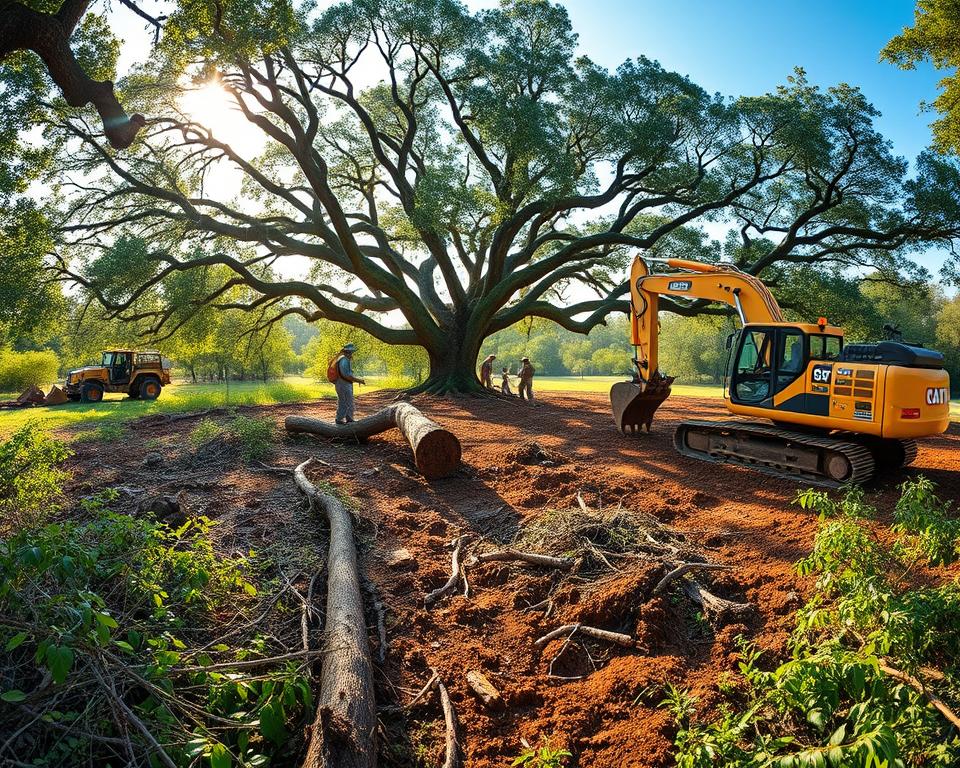Professional Tips: Forge Trails in Forest Property
Did you realize nearly 80% of property owners with forest property seldom venture past their yard? That statistic underscores the critical need for effective trail opening and maintenance. Clearing routes and footpaths in wooded zones not only improves reachability but also improves safety and wayfinding. This article will explore expert methods and perspectives from seasoned trail builders.
These experts will provide how to design properly-constructed pathways that maximize your outdoor area’s usefulness while maintaining its ecological wholeness. Learn the key factors for forestry mulching near me and techniques for efficient wooded property maintenance solutions. Such can render your experience through your natural surroundings more delightful.
Important Discoveries
- Comprehending the value of opening paths for accessibility and security.
- Evaluating site attributes to determine the purpose of your trails.
- Using the appropriate tools for effective trail opening.
- Choosing suitable surfaces that match with landform.
- Adopting eco-friendly practices when opening paths.
- Recognizing frequent mistakes to avoid during the path-opening process.
Significance of Path Clearing in Woodland Estates
Preserving open paths in wooded areas is vital for several reasons. It greatly enhances accessibility, making it easier to navigate dense foliage. This allows property owners and visitors to completely appreciate the landscape. This clearing also facilitates different pursuits like walking, birdwatching, or just relishing nature.
Boosting Access
Open trails not only facilitate travel; they also deepen our link with nature. Through enhancing approachability, owners make available the open air to more people. Such benefits is beneficial for personal use or group gatherings, fostering discovery and valorization of the surroundings.
Enhancing Safety and Direction
The significance of security on woodland trails is immense. Defined paths provide clear navigation and minimize risks from uneven terrain, concealed barriers, or sudden plant growth shifts. Landholders commit in establishing safe routes, boosting assurance in outdoor adventures.

Designing Your Forest Path
Successful trail design requires a deep knowledge of the landscape. It’s about evaluating terrain and location conditions. Knowing the path’s purpose is also key, as it informs design and upkeep.
Assessing Ground and Location Attributes
When assessing terrain, multiple elements are essential. These include:
- Soil types that affect water flow and steadiness
- Incline angle affecting ease of access and safety
- Current plant life that may require clearing or protection
By evaluating these elements, paths can withstand different climatic factors. They also support frequent foot traffic. Such planning ensures the trail is durable and honors the ground’s original characteristics.
Defining Your Trail’s Purpose
Trail design achievement depends on a well-defined objective. Think about the activities the path will serve, such as:
- Leisurely strolling and nature appreciation
- Access for maintenance or land management
- Chances to watch fauna and learning
Knowing the path’s goal guides many choices. This includes the path’s width and construction materials. Identifying the path’s goal is crucial for crafting a route that meets its needs.
Essential Equipment for Path Opening
Effective trail opening demands the proper tools for different tasks. The appropriate equipment increase productivity and safety, streamlining the procedure. The choice between manual tools and motorized equipment depends on the project’s size, ground, and amount of debris.
Fundamental Handheld Tools
Hand tools are essential for precision and versatility in clearing overgrown zones. Essential tools include:
- Pruning loppers: Great for cutting through heavy branches and bushes.
- Handsaws: Perfect for detailed slicing on trees.
- Digging tools: Handy for excavating and forming drainage ditches.
These tools provide a hands-on approach, crucial for delicate areas where heavy equipment could harm.
Power Tools for Productivity
For large-scale path clearing projects, power tools are a game-changer. They make the task faster and more productive. Crucial equipment include:
- Chainsaws: Excellent for cutting down large trees and slicing dense undergrowth.
- Brushcutters: Fast for clearing dense grass and young shoots.
Power equipment reduces clearing duration, making it ideal for large areas. Secure operation is imperative to avoid injuries.
Approaches for Path and Trail Preparation
Opening routes and tracks in forest areas demands careful planning. It’s essential to balance practicality with eco-friendliness. Efficient plant control maintains the environment’s harmony while establishing functional pathways. This balance is crucial to a pleasant outdoor encounter.
Removing Excess Growth
Targeted removal techniques are vital when tackling overgrowth. Manual implements allow for precise extraction of unwanted plants without harming the habitat. This method promotes the growth of preferred species while controlling foreign ones. Ongoing upkeep prevents regrowth, enhancing path security and ease of travel.
Creating a Sustainable Pathway
A sustainable route design is more than aesthetic; it involves selecting resources that minimize soil loss and enhance drainage. These methods honor the environment and reduce ecological impact. Employing native stones or recycled timber supports long-term durability and ecological harmony. Thoughtful planning strikes a balance between functionality and environmental preservation.
Selecting Ideal Trail Surfaces
Choosing the appropriate trail surface is vital for both functionality and durability. The decision between natural and artificial coverings impacts maintenance, user experience, and trail longevity. Understanding the different options and their suitability for your ground is key to establishing an ideal route.
Natural vs. Man-Made Surfaces
Organic ground covers, such as gravel, broken rock, or mulch, are often more affordable. They blend well with the environment, facilitating water flow and a organic look. In comparison, synthetic covers like concrete pavers are more long-lasting and suitable for heavy use. Every option has its advantages and disadvantages, depending the intended use and environmental conditions.
Choosing the Right Materials for Your Terrain
Choosing the right resources includes evaluating ground composition, water requirements, and budget. Below is a basic guide to popular materials:
| Material | Advantages | Disadvantages | Cost per Square Foot |
|---|---|---|---|
| Gravel | Inexpensive, Effective water flow | May need frequent replenishing | $1 – $3 |
| Crushed Stone | Steady footing, Organic appearance | Potentially slippery when wet | $2 – $5 |
| Wood Chips | Environmentally friendly, Soft underfoot | Needs frequent topping up | $1 – $2 |
| Concrete Pavers | Durable, Low maintenance | Higher upfront cost | $5 – $15 |
Thoughtfully choosing ground coverings guarantees your routes are practical and enhance the area’s natural beauty.
Constructing Elevated Walkways
Creating paths in forest areas demands careful consideration of level shifts. This is key for even crossings across different landforms and maintaining trail usability over time. Constructing overpasses for trails is often required, mainly when spanning wet areas or natural depressions.
When to Consider Elevation Changes
Elevation in trail layout is often due to uneven landscapes. Major drops or rises require structures like overpasses or turnpikes to maintain trail soundness. This approach helps prevent soil erosion and ensures user safety, essential for both leisure walkers and serious outdoor enthusiasts.
Choosing Bridge Materials for Marshy Terrain
The choice of supplies for turnpikes and bridges is key for their security and longevity. Timber beams, masonry units, or treated lumber can offer the required strength against weight and weather conditions. It’s crucial to choose materials that are moisture-proof to prevent degradation and allow subsequent adjustments.
Sustaining and Servicing Trails
Keeping paths secure and open requires ongoing maintenance. Regular checks assist in spotting problems early, making sure users have a positive experience. It’s vital to maintain trails throughout the year, as weather changes can damage them. This part will outline a detailed maintenance checklist and the benefits of employing professional trail maintenance services.
Seasonal Maintenance Checklist
A thorough guide helps trail owners keep their trails in prime condition year-round. Important tasks include:
- Removing debris such as fallen branches and leaves.
- Inspecting trail surfaces for damage, after bad weather.
- Checking drainage systems to prevent flooding.
- Repairing erosion by supplementing material as required.
- Updating markers and signs for clear navigation.
Professional Trail Maintenance Services
For those requiring professional help, specialized trail maintenance services are a great choice. They offer:
- Comprehensive path evaluations by experienced experts.
- Advanced restoration and rehabilitation of busy paths.
- Using dedicated machinery for improved path treatment.
- Applying eco-friendly methods to extend trail life.
Engaging professional trail maintenance frees up time for other outdoor pursuits. It also introduces expert skill.
Beautifying Trail Borders
Landscaping is key to rendering paths visually appealing. By thoughtfully selecting plants and elements, you can create an welcoming space. This not only attracts visitors but also aids local habitats. The right vegetation for trails add beauty and sustain environmental stability.
Adding Plants for Attractiveness
When planning pathside planting, selecting the right plants is essential. Local species are ideal as they naturally blend with the surroundings. They need less maintenance and provide homes for local wildlife. Combine flowering plants, shrubs, and grasses for a diverse, appealing setting around trails.
Using Stones and Edging Materials
Edging materials like rocks and pavers are vital for path form. They outline the route and contribute to its design. These materials prevent soil erosion and provide a clean contrast with vegetation. Employing varied finishes and colors can make the path more interesting.
Environmental Considerations in Trail Clearing
Trail opening tasks should prioritize eco-consciousness. Sustainable ground care methods help preserve the site’s environmental health. This approach makes sure paths coexist with the natural world peacefully.
Sustainable Practices for Land Management
Embracing sustainable practices in trail clearing is critical. Minimal-impact methods minimize land degradation and safeguard habitats. Selective clearing and eco-friendly supplies minimize damage.
Learning the terrain and vegetation is crucial. It supports ethical clearing and enhances trail usability.
Impact on Local Wildlife and Flora
Wildlife impact assessments are important in path development. They assist gauge the task’s effect on local animals and plants. This permits for necessary changes before construction starts.
Identifying sensitive species’ habitats avoids ecosystem disturbance. This equilibrium ensures a healthy ecosystem for every form of life.
Path constructors can design sustainable pathways with careful preparation. This focus to environmental sustainability and fauna protection improves nature engagement. It balances leisure pursuits with eco-protection.
Common Mistakes to Avoid While Trail Clearing
Engaging in path opening demands avoiding common pitfalls to prevent ongoing problems. Recognizing these errors enables for better preparation and execution. By emphasizing straightforward path layout and managing water flow, one can avoid costly maintenance needs.
Overengineering Trail Layouts
Path management often falls into the pitfall of over-complicating path design. Many enthusiasts believe elaborate layouts render paths more attractive. Yet, straightforwardness is often the key to effectiveness. Straightforward routes enhance navigation and upkeep, reducing hurdles.
Unnecessary turns and intricate features can cause trail design errors. These errors complicate utilization and wayfinding, making paths less enjoyable.
Neglecting Water Management
Neglecting water control issues in trails can have severe outcomes. Proper drainage planning avoids water accumulation, which can wash out trails and damage landscapes. Adequate water control measures are crucial for a long-lasting trail.
Ensuring water flows away from the path safeguards the pathway and preserves the ecosystem. This enables for a more enjoyable outdoor experience.
Final Thoughts
Path clearing is essential for those who desire to completely enjoy their wooded grounds. It improves accessibility and safety, making outdoor spaces enjoyable for all. Woodland paths provide more than just scenic appeal; they offer opportunities for recreation and education about the ecosystem.
Effective planning and execution are crucial in trail clearing. Evaluating terrain and selecting the proper materials are vital for creating durable routes. Regular upkeep ensures these paths secure and accessible, fostering a ongoing connection with the outdoors.
By understanding the concepts discussed here, you can design and upkeep trails that serve both functional and recreational needs. Adopting forest trails can turn your grounds into a sanctuary for adventure, relaxation, and appreciating the environment.

